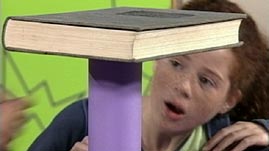Teachers' Domain - Digital Media for the Classroom and Professional Development
User: Preview


Source: ZOOM
Columns: Finding the Strongest Shape (Document)
(humming)
VOICE: (gasps) Ooh!
PABLO: Tom G. of Revere, Massachusetts, sent us this challenge. Make four shapes of paper—a tent, a triangle, a box and a cylinder—then test them to see which one can hold the most books.
ALISA: What do you think will happen?
PABLO: Well, I think the tent will not support not even one book, because it's, like, there's not much support. There's just this thing right here, and they'll just go...
ALISA: There's nothing, like, underneath to help it stay up.
PABLO: This might, but... I don't know.
ALISA: I think these three might work good.
PABLO: Maybe.
ALISA: Let's test this one first, because these all look like they have enough support, so maybe they'll work. Okay, do it gently. I'm not even putting it on. Whoa... that was a flop.
PABLO: No, I don't think...
ALISA: Let's try it another way.
PABLO: How about the long way?
ALISA: Okay. Kerplunk. Okay. (imitating plane dive-bombing)
PABLO: Guess that one didn't work because, um... it was just... it was, like, this was no support—the support was right there.
ALISA: In the fold.
PABLO: All right, let's test...
ALISA: Triangle?
PABLO: Triangle. This one looks like it can support it.
ALISA: Yeah. Um... nope. I have to say that didn't work.
PABLO: Uh... Why do you think it didn't work?
ALISA: Maybe because, like, where the folds are, there's the most strength, because it can hold my finger up, but right here, there's no strength so that the book—when I put pressure here, it collapsed.
PABLO: Oh.
ALISA: So... Okay, this one now?
PABLO: Yep.
ALISA: This is almost the same thing as the triangle, so do you think it will work? Because it's got the folds, and then this part...
PABLO: It will probably do the same thing as the triangle, but let's just see.
ALISA: A girl's touch is always more careful.
PABLO: Yep. (gasps)
ALISA: No! You have to face it—our square...
PABLO: Oh, but it almost did.
ALISA: I know, it, like, stayed for, like, a "ding!" and then it dropped. You're our only hope.
PABLO: Come on, Mr. Cylinder.
ALISA: Okay, so, you have to place the book right even, right?
PABLO: Yeah.
PABLO AND ALISA: Yeah!
ALISA: Whoa, watch out!
PABLO: Okay.
ALISA: Okay. Try the next one.
PABLO: No! But at least it held one.
ALISA: Yeah.
PABLO: Well, first—why do you think it did hold?
ALISA: Because, remem... Well, I think because, like, you know how I said that the folds were, like, stronger and the sides were, like, bleah? Well, it's all the same. All the weight is even on this...
PABLO: Oh!
ALISA: So it, like, took it evenly. Hip, hip, hooray! Yay!
 Loading Standards
Loading Standards Teachers' Domain is proud to be a Pathways portal to the National Science Digital Library.
Teachers' Domain is proud to be a Pathways portal to the National Science Digital Library.
